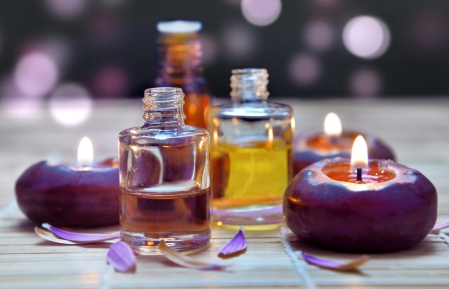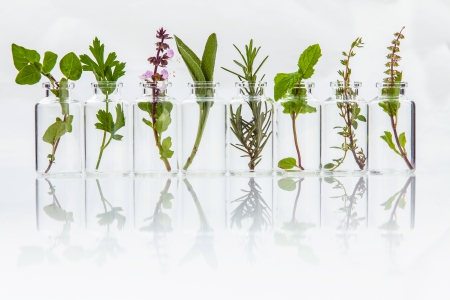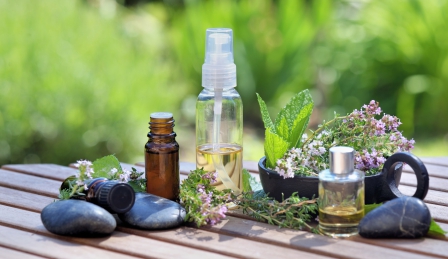Essential oils are concentrated aromatic mixtures of several chemical substances derived from plants. They are basically extracted from various parts of plants like root, buds, fruits, flowers, bark and leaves. They have been traditionally used for medicinal purposes. They also have significant health benefits. Recently, they are widely used for synthesizing several medications and therapeutic supplements.
Characteristics
- Essential oils are organic and volatile compounds
- They are basically colorless
- They are hydrophobic in nature
- They are generally less dense than water
- They are also less viscous than oil
- They are highly aromatic and have a characteristic flavor
- They are generally liquid in nature (in normal room temperature)
Nutritional profile
- All essential oils contribute energy on their oxidation as they all contain more or less crude fat
- They contain aromatic and aliphatic compounds
- They contain both polar and non-polar biochemical substances
- They contain significant amount of minerals, which include calcium, phosphorus, sodium, potassium, iron and magnesium
- They contain several organic substances like aldehydes, ketones, alcohols and phenols, especially citral, eugenol, cinnamaldehyde, thymol, carvacrol,
- They also contain hydrocarbons, such as terpenes and terpenoids, phytonutrients such as eicosane, uncineol and other bioactive molecules like delta-3-carene, α-trans-bergamatene, limonene, germacrene and β-eudesmol

Extraction of essential oil
All the essential oils present in various parts of plants are obtained by using several extraction methods, which are listed below –
- Steam distillation
- Cold press extraction
- Water distillation
- Enfleurage
- Carbon dioxide extraction
- Maceration
- Recently, chemical solvent extraction methods are used for obtaining essential oils and oils derived from this method are basically termed as absolute or concentrate
Example of essential oils
Most significant essential oils derived from various plants are listed below –
- Cinnamon oil
- Lemon oil
- Clary sage
- Lemongrass oil
- Tea tree oil
- Lavender oil
- Peppermint oil
- Eucalyptus oil
- Sweet orange oil
- Rosemary oil
- Ylang-ylang
- Chamomile
Biological activities of essential oils
Antioxidant activities
- The phenolic compounds of essential oils such as thymol, euginol, carvacrol are considered as the principal compounds that exert antioxidant activities
- Other organic constituents of essential oils like aldehyde, alcohols, ketones, esters are also act as antioxidant
- They all have well free radical scavenging capacity and help to reduce the concentration of free radicals in body
- They also help to prevent the prevalence of cancers, neurological disorders, immunological dysfunctions and cardiovascular diseases

Antimicrobial activities
- The hydrophobic nature of essential oil is responsible for exerting antimicrobial activities. Essential oils help to disrupt the structure of microbial cell membrane by binding with the membrane lipid (due to hydrophobicity) and results in enhancing cellular permeability. These are accountable for great losses of microbial cellular component, resulting in cellular death
- Aldehyde, alcohol and phenolic components of essential oils also help to prevent microbial growth and reproduction within host
Anti-inflammatory activities
- Terpenes (especially terpene alcohol) of essential oils act as strong anti-inflammatory substances
- They help to reduce inflammation by inhibiting the secretion of inflammation mediators
- It mainly helps to treat allergies, rheumatism, swelling, pain and arthritis
Anti-carcinogenic activities
- All essential oils derived from various plant sources show chemo protective activities
- They help to prevent malignant cell growth by enhancing apoptosis and help in the complete destruction of cancerous cells by their potent cytotoxic effects
Allelopathic Activities
- Secondary metabolites of essential oils are accountable for exerting alleopathic activities
- They help in the growth and development of several biological and agricultural substances

- Other important biological activities of essential oils focused on their ability of killing insects. They can be used as strong insecticides
Health benefits
Role on mental health
- Essential oils are associated with promoting mental health by enhancing mood and body’s ability for performing tasks
- They have been traditionally used as an effective measure for preventing anxiety and stress
- It has seen that they help to restore nervous system by reducing heart rate and blood pressure, which are associated with providing a calmness, which is accountable for preventing anxiety
- They also help to prevent restlessness
Role on sleep
- Essential oils help to prevent insomnia and promote healthy sleeping
- All essential oils (especially lavender oil) can provide a relaxing effect by changing brain wave and by reducing body temperature, heart rate and hypertension. These shooting effects facilitate sleeping
- It is better to use any essential oil during bedtime as it helps to improve sleeping quality
Role on preventing headache
- Essential oils help to relax muscle and help to prevent headache
- It has seen that breathing in essential oils (especially lavender oil and peppermint oil) help to treat migraine

Role on gastrointestinal health
- It has seen that several essential oils (especially peppermint oil) help in digestion
- Usage of essential oil is closely related with preventing constipation. They help in regulating intestinal smooth muscle contraction and relaxation resulting in easy defecation
Role on muscle
- All essential oil (especially eucalyptus oil) shows a cooling effect on muscle
- They help to prevent muscle soreness, pain and inflammation
- They also help to reduce muscle spasm by enhancing soothe muscle tension
Role on immune system
- Antioxidant, anti-inflammatory, antimicrobial and polyphenolic components of essential oils are responsible for enhancing immunological responses of the body
- They help to prevent the prevalence of infectious diseases
- They are significantly helpful for reducing cold sore
- They help to clear congestion and help to prevent normal fever and coughs
Recent findings
- Recent researches have shown that nanoemulsions of essential oils act as potent antimicrobial agent and help in food preservation by inhibiting microbial spoilage of food. Nanoemulsions promote mass transfer of essential oils into microbial cell membrane and reduce their growth and proliferation (Donsì and Ferrari, 2016)
- Current studies and researches have shown that usage of essential oils (especially rosemary or eucalyptus) loaded with nano structured lipid carrier and solid lipid nanoparticals help in rapid wound healing and tissue regeneration (Saporito et al., 2018)
- Recently, insomnia becomes a very common health problem that affects the physical and mental health adversely. Essential oils can be utilized as an effective preventive measure for insomnia. Recent researches have shown that inhalation of Kabuchii essential oil vapour is associated with preventing insomnia due to its strong sedative effect. Kabuchii is a type of citrus fruit and it is related with providing a relaxing effect that stimulates healthy sleeping. Using of this essential oil can easily replace the harmful consequences of sleeping pills (Kobayashi et al., 2016)

Risk factors
- Inhalation of too much essential oils often develop headache
- People with asthma should avoid the usage of essential oils, as it may develop some harmful consequences
- It may also cause difficulty in breathing in excessive amount
- It may develop irritation or burning sensation of throat and eyes
- Excessive usage of essential oil may develop allergic reaction in some people and also develop skin rashes
- It may also develop nausea and vomiting in some people

Source:
Dhakad, A.K., Pandey, V.V., Beg, S., Rawat, J.M. and Singh, A., 2018. Biological, medicinal and toxicological significance of Eucalyptus leaf essential oil: a review. Journal of the Science of Food and Agriculture, 98(3), pp.833-848.
Donsì, F. and Ferrari, G., 2016. Essential oil nanoemulsions as antimicrobial agents in food. Journal of biotechnology, 233, pp.106-120.
Kobayashi, Y., Takemoto, H., Fua, Z., Shimizu, E. and Kinjo, Y., 2016. Enhancement of Pentobarbital-induced Sleep by the Vaporized Essential Oil of Citrus keraji var. kabuchii and its Characteristic Component, y-Terpinene. Natural product communications, 11(8), pp.1175-1178.
Manion, C.R. and Widder, R.M., 2017. Essentials of essential oils. American Journal of Health-System Pharmacy, 74(9), pp.e153-e162.
Rana, M., Bhatt, T.D. and Upadhyay, S., 2017. A Short Review on the Study of Essential Oils. Journal of Plant Resources, 15(1), p.66.
Saporito, F., Sandri, G., Bonferoni, M.C., Rossi, S., Boselli, C., Cornaglia, A.I., Mannucci, B., Grisoli, P., Vigani, B. and Ferrari, F., 2018. Essential oil-loaded lipid nanoparticles for wound healing. International journal of nanomedicine, 13, p.175.
Swamy, M.K., Akhtar, M.S. and Sinniah, U.R., 2016. Antimicrobial properties of plant essential oils against human pathogens and their mode of action: an updated review. Evidence-Based Complementary and Alternative Medicine, 2016.
Valdivieso-Ugarte, M., Gomez-Llorente, C., Plaza-Díaz, J. and Gil, Á., 2019. Antimicrobial, antioxidant, and immunomodulatory properties of essential oils: A systematic review. Nutrients, 11(11), p.2786.



